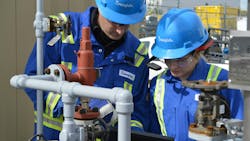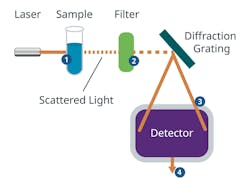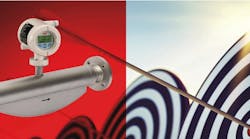Every chemical plant or refinery must employ accurate process analyses to verify that process conditions and fluid composition are as expected. Performing continuous process analyses allows facilities to maintain ideal efficiency and profitability. The more operators know about the process fluids in their facility, the better they will be able to manage the fluids with proper controls.
That is why choosing the right process analyzer is critical to operating a plant successfully. How operators determine which analyzer to use depends entirely on what they are trying to accomplish. In some instances, a new type of process analyzer called a Raman analyzer is the right choice. It uses Raman spectroscopy to determine in detail the chemical composition of a fluid. Since Raman analyzers are relatively new, understanding what they can do and knowing under what circumstances they might be the best choice of process analyzer for a facility are useful.
How Raman analyzers work
Raman analyzers differ from other analytical tools because they are nondestructive and offer detailed examinations of the chemical compositions of liquids, solids or gases. To complete the analysis and determine the composition of any sample, technicians employ monochromatic lasers in the visible, near infrared or near ultraviolet ranges. The laser light causes the electrons within molecules of the substance to vibrate and move to a virtual vibrational state.
As the molecules vibrate, they produce elastic and inelastic scattering of light. Elastic scattering, also known as Rayleigh scattering, indicates that released light photons are equal in energy to incident light photons. Inelastic scattering, or Raman scattering, occurs at either one of two times:
- First, electrons within molecules can reach their virtual state and keep some of the energy they absorbed from the laser. In this instance, the emitted scattered light photon produces a longer wavelength and contains less energy than the incident photon.
- Second, electrons within molecules that were already in an excited vibrational state eventually revert to their ground state after being excited by the laser, which emits light photons. These photons have a shorter wavelength and have higher energy than before they were excited.
The Raman spectrum produced in this operation can be referred to as the Raman fingerprint of a sample. Like human fingerprints, Raman fingerprints are unique to each specific sample. Operators can assign value or values to them using mathematical models generated for measurement applications. Operators can produce these models in a lab themselves, but many manufacturers prefer to produce theoretical models, which can cut down on how much time it takes to implement them. It is important to note that careful modeling and proper application of models — no matter how they are produced — is crucial to making sure Raman measurements are accurate.
When Raman analyzers should be used
If operators want to monitor the health of their processes continuously over time, Raman spectroscopy is an excellent analysis method. It can confirm the chemical compositions of samples at each stage of the process, which can provide operators with vital data on optimal operation. Raman analysis performed at optimal points in the process minimizes rework and waste of process fluids. A properly constructed Raman system provides nearly instantaneous feedback so operators can adjust when necessary. Additionally, Raman spectroscopy can help evaluate finished or nearly finished products to ensure they meet the necessary quality standards.
There are additional operational benefits too, including:
- Little to no sample conditioning required, helping to reduce startup and ongoing maintenance costs.
- Minimal to no sample transport time, greatly reducing time delays and providing near real-time analysis.
- No manual calibration required.
- Minimal maintenance needs over the course of the analyzer’s lifetime.
Raman Analyzer shortcomings
Instead of basing the testing results on tangible comparisons, Raman analyzers determine test results by relying on models. While gas mixture components are often easily differentiated using linear regression analysis, analyzing liquids using this method is more complex. Developing liquid models can take months — and sometimes years — meaning they cost more upfront and cannot be deployed immediately.
In addition, Raman analyzers are not as granular as other methods. They can usually measure down to only a few hundred parts per million. This renders Raman analysis less useful for certain applications.
Common applications for Raman analysis
Raman spectrometers are suitable for a wide range of process applications, including:
- Gasoline blending. Raman spectrometers have proven quite effective in gasoline blending applications. Octane rating, boiling points and Reid Vapor Pressure (RVP) can all be effectively measured using Raman spectroscopy. With fast responses and accurate analyses, operators can, for example, maintain the optimal octane rating of their final product while minimizing giveaway.
- Natural gas quality measurement. Hydrocarbon components in natural gas can vary from only trace amounts to nearly 100% of the mixture. Inert gases present in the natural gas mixture can reduce its energy density, and therefore its value. Raman spectroscopy is a good choice for fast and accurate natural gas measurement as it does not require separation of the components like the traditional gas chromatography method.
- Hydrotreating and hydrocracking. Hydrogen is of critical importance in refining operations. Raman spectroscopy is a good solution when a full composition analysis is required. After a pressure swing absorption unit, real-time Raman analysis can help operators ensure proper hydrogen removal before suboptimal product has flowed downstream. Additionally, Raman spectrometers can generally measure at higher pressures than other methods. This increases the likelihood of returning the fluid to process rather than flare, helping to reduce operating costs and emissions.
- Drilling exploration. Optimizing the drilling process while supporting safety for operators is critical as drillers search for oil and gas reserves. Increasing drilling speeds requires faster measurement response that cannot be achieved by traditional measurement technologies, such as gas chromatography. The Raman spectrometer’s ability to simultaneously measure both hydrocarbon and nonhydrocarbon molecules decreases the need for additional analytical instrumentation.
- Mud logging. Mud logging is the measurement and cataloging of rock cuttings, mud and gases that are driven to the surface during borehole drilling. Monitoring the composition and characteristics of the mud is critical to optimize the drilling process and ensure that an explosive mixture of gases is not present. The continuous monitoring provided by the Raman spectrometer helps operators make informed decisions that increase efficiency and help maintain operational safety.
Raman analyzers in action
Raman analyzers are ideal for checking the chemical composition of refinery fuel gas, which typically consists of natural gas and recovered flare gas. The quality of the fuel gas can change rapidly when recovered flare gas is introduced, which can cause inefficiencies in the equipment that mixes the fuel gas. In particular, boilers often suffer flame instability if hydrogen levels in the fuel gas spike.
Since Raman analyzers produce such quick results, they can measure hydrogen levels in the fuel gas continually, and technicians can adjust the mixing process quickly if hydrogen levels are too high. Catching these levels early prevents hydrogen-rich fuel gas from interfering with the efficiency of the mixing process.
Are Raman analyzers right for you?
Evaluating whether Raman analyzers are the right choice for a facility depends on its specific process analysis needs. If there is a question about whether Raman analyzers might be a good fit, consult with a qualified analyzer supplier who can guide you through the decision-making process to determine their usefulness for specific applications.
Mike Strobel is the director of engineering services for Swagelok NYC | NJ | Philadelphia.
An original version of this article appeared on the Swagelok Reference Point blog here.




